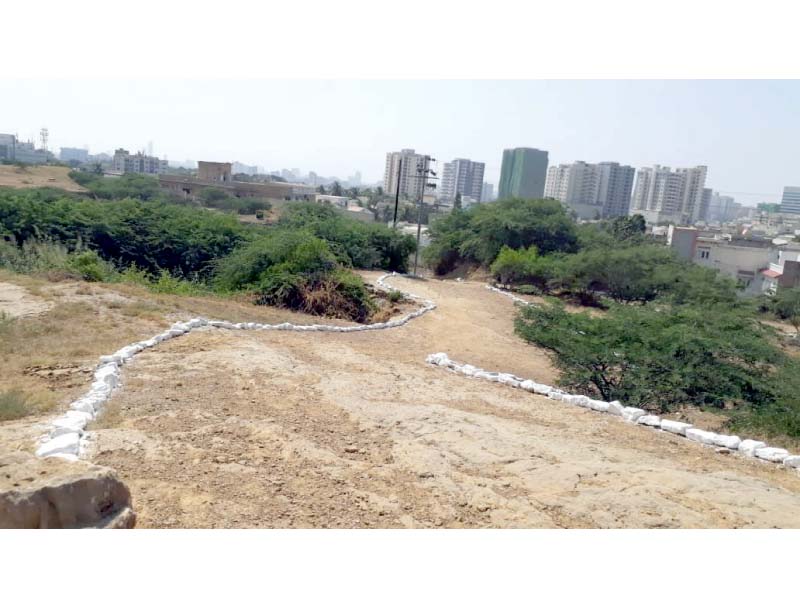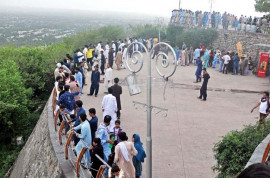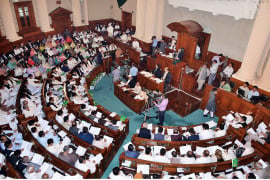
Located at a stone’s throw from Rangoonwala Hall and Bahadurabad Chowrangi, Kidney Hill Park suffered the same fate for decades. After its doors were closed to the public some 50 years ago, the land it was established upon was illegally occupied by both public and private entities.
That is until the start of this year when the Supreme Court ordered a massive anti-encroachment drive in the city. As part of efforts to clear out land occupied by encroachers, city authorities demolished illegal structures erected within Kidney Hill Park premises, which included, rather surprisingly, an entire colony for Karachi Water and Sewerage Board (KWSB) staff.
UN Habitat to extend support for clean, green movement in Pakistan
With the park land now free, the Karachi Metropolitan Corporation has been keen to re-establish Kidney Hill as a state-of-the-art urban forest on a par with Islamabad’s Daman-e-Koh. For the past month-and-a-half, the officers and staff of KMC, the Horticulture Department, Karachi Zoo and the city’s municipal services have been working to beautify the park.
A makeover in progress
According to officials, all unkempt trees and shrubs have been groomed, while the trails have been cleaned and flattened to make them easier to traverse. Stray dogs have also been removed from the park with the help of the Edhi Welfare Foundation, they said.
“We are currently in the first phase of the project and carrying out departmental work,” Municipal Commissioner Dr Saifur Rehman told The Express Tribune. “We are currently planting trees - we plan to plant as many as 10,000 in phase one - and clearing out the various park trails,” he said.
“KMC is growing more than 25 types of plants in the park,” said Karachi Zoo’s Senior Recreation Director Mansoor Qazi. “We have planted 7,000 so far.” He added that the plan envisions six types of forests within the park: “There will be a timber forest, a fruit forest, a creeper forest and a jungle-type environment. We will also have stretches with medicinal plants and bushes and shrubs.”
According to Qazi, most of the plants have been sourced by KMC from its nurseries. In addition to that, Indus Motors, MUFG Bank and Al-Habib Bank have donated 3,500 plants. The medicinal plants and fruit trees being grown include banana, mango, dates, lemon, sapodilla, malta, papaya, coconut, blackberry, guava, apricot, fig, banyan, tamarind, morinaga and wood-apple among others.
Thousands of tonnes of litter have also been removed from park land as part of phase one, Municipal Commissioner Rehman said. “As many as 500 trucks lifted the garbage, dumped by both residences and businesses in the vicinity, from the park. We also plan to carry out a special cleanliness drive with civil society volunteers shortly.”
He outlined that the plan is to create 12 corridors in the park. “These will be named after renowned Pakistani tourist spots, like Saiful Muluk, Karakoram, Rakaposhi and Dhoraji,” he said. While no trees would be chopped down to make way for the corridors, the authorities will trim down shrubs and bushes around them. “All this work will be completed in a month and the park will be opened to the public.”
Rehman added that four gates have been installed to restrict the movement of potential miscreants. “We have also deputed a city warden.”
According to the municipal commissioner, a consultant will be hired in phase two to create a comprehensive plan for the park. “We want an aviary and an open enclosure on the pattern of Safari Park. We also want a play area for children and an artificial lake along with a cafeteria or canteen,” he said.
Pushback from ‘influentials’
The plan to re-establish Kidney Hill Park did not stay immune to resistance from other quarters. According to KMC officials, several influential individuals tried to pressure the corporation into giving up the initiative.
“It was a difficult phase, but Municipal Commissioner Rehman not only stood up to the pressure but made it very clear that this project was being carried out in accordance with the Supreme Court orders,” said one KMC official. “Thanks to his stance, any resistance to the project has now subsided.”
Much needed oxygen
Kidney Hill’s urban forest is expected to make a significant addition to Karachi’s otherwise sparse tree population. By itself, however, it will not be enough to improve the city’s environmental conditions, according to experts.
DG Khan Safari to open in December
“KMC’s forestation efforts in Kidney Hill Park are a great step, but they should be followed up with a comprehensive plan to increase greenery in Karachi,” said Horticulture Society of Pakistan Council (HSPC) member Rafiul Haq. “Not only should the plants being grown there be looked after persistently, but a massive plantation campaign should also be carried out on other vacant lands in the city.”
According to Haq, Karachi needs at least 140 million trees to keep it from becoming an urban heat sink. “Due to numerous concrete structures, including high-rises, and road development, it has become more and more important to grow more trees. Concrete and the material used in roads releases heat for a long time, increasing temperature intensity in the city.”
Kidney Hill, then and now
The land for Kidney Hill Park was allocated by the Karachi Development Authority (KDA) in KDA Scheme 32 in 1966. Owing to its geographical outline and the many natural hills in its vicinity, it adopted the peculiar name of Kidney Hill Park, which was later changed to Ahmed Ali Kidney Hill Park after KDA Senior Director of Planning, Ahmed Ali.
However, there’s little KDA can be credited for besides allocating land and erecting a kidney-esque boundary wall around the public park, before handing it over to Karachi Municipal Corporation, which too failed to do much for the park in terms of development and maintenance and it was left for the howls of stray dogs and criminal elements to haunt for decades.
Published in The Express Tribune, October 30th, 2019.



































COMMENTS (1)
Comments are moderated and generally will be posted if they are on-topic and not abusive.
For more information, please see our Comments FAQ